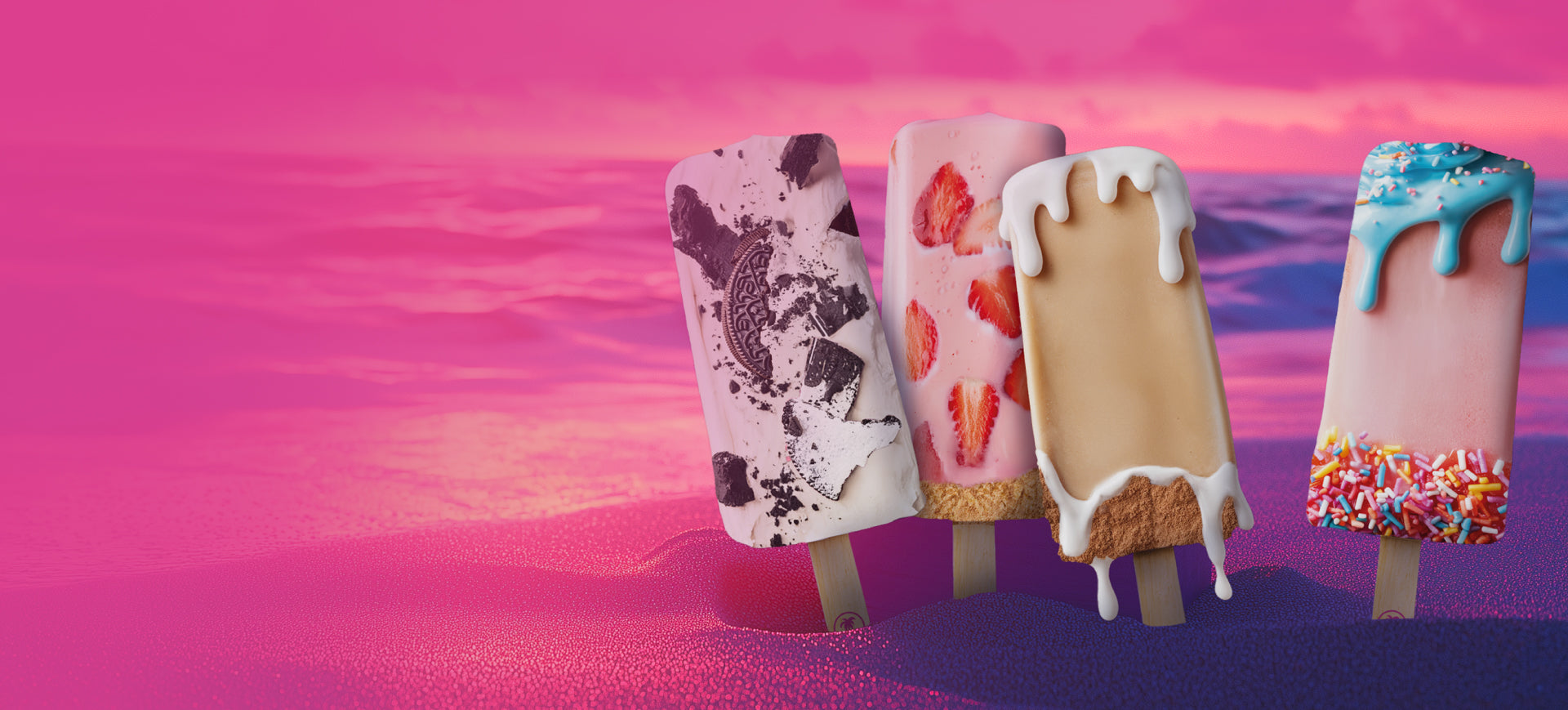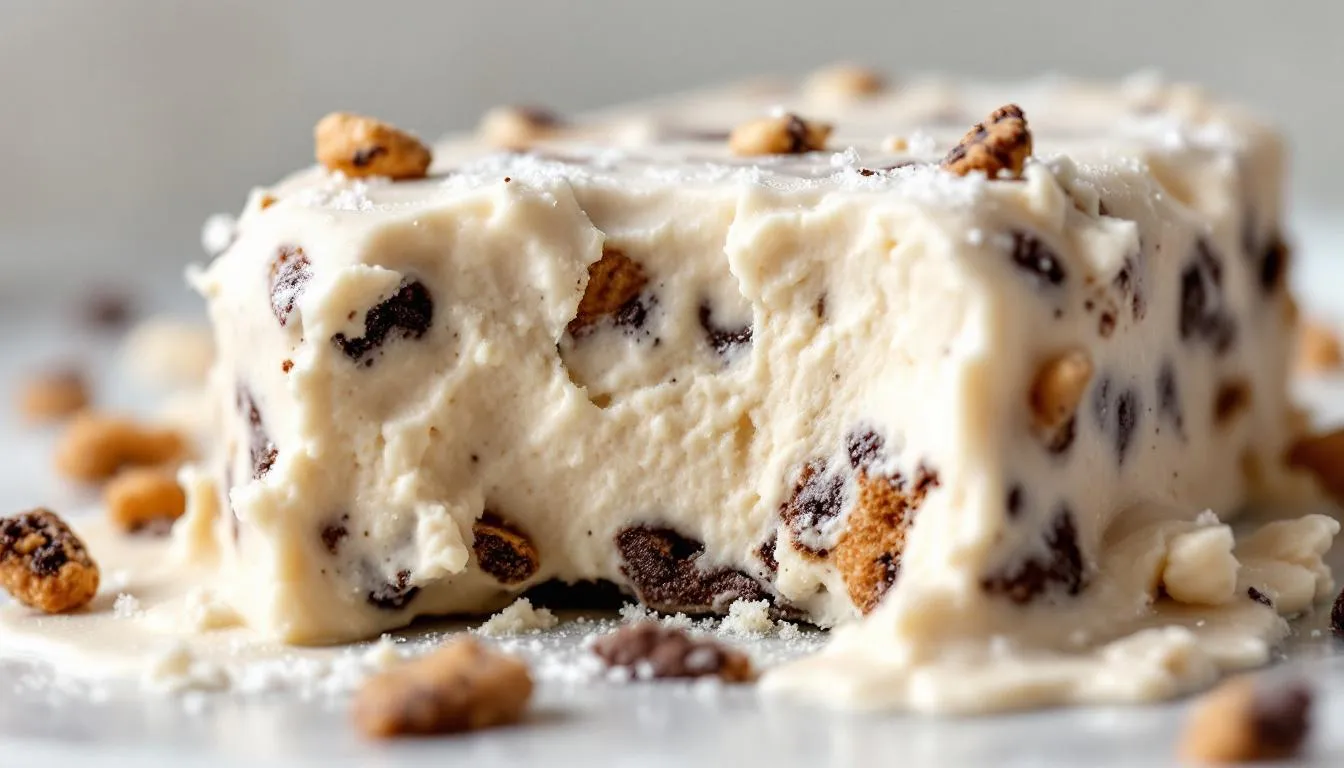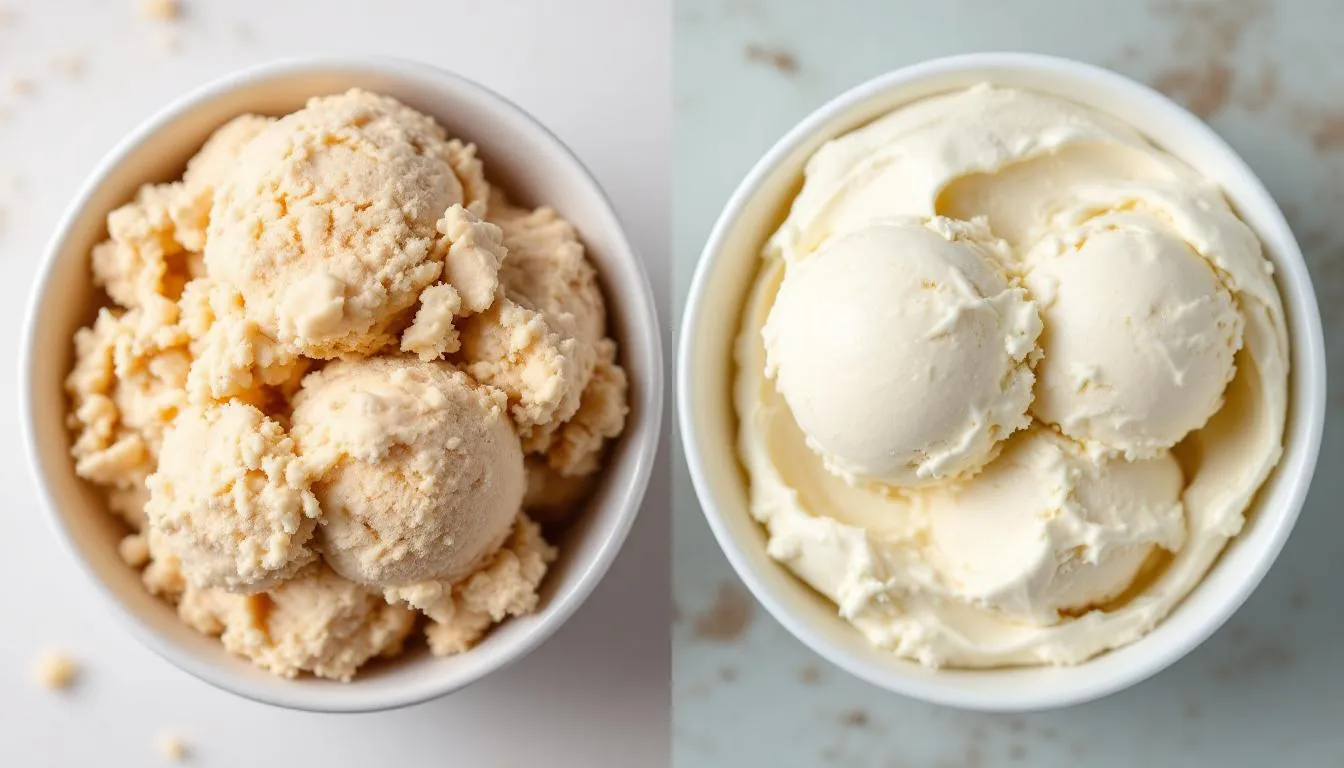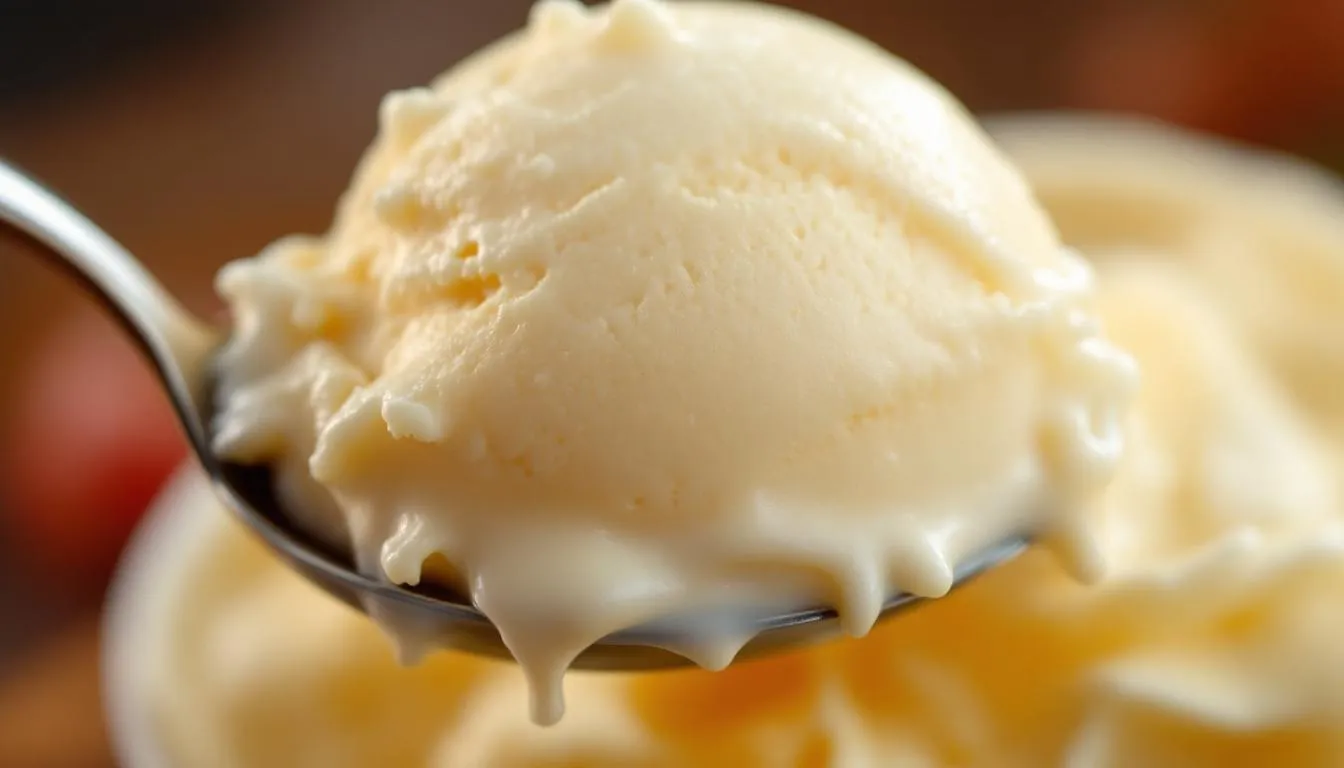

The Best High Protein Ice Creams: Taste-Tested Favorites You’ll Love

High Protein Ice Cream: Your Guide to Guilt-Free Frozen Treats That Actually Taste Good
We get it - you want your sweet tooth satisfied without completely derailing your protein goals. As the team behind California Ice Protein bars, we've spent countless hours figuring out how to make protein ice cream that actually tastes like ice cream, not frozen protein powder. And after trying virtually every high protein ice cream on the market, we can tell you this: most brands are missing the point entirely.
The truth is, high protein ice cream has come a long way from the chalky, artificial-tasting disasters that used to dominate freezer aisles. But here's what hasn't changed: most brands still ask you to compromise. They want you to accept that weird protein powder aftertaste, that dense texture that's nothing like real ice cream, and that artificial sweetener flavor that screams "diet product."
We refused to accept that compromise. That's why we spent months perfecting our bars - 15 grams of protein, ~200 calories, and most importantly, taste that doesn't require excuses or mental gymnastics to enjoy.
After testing countless pint-based ice creams and protein-packed frozen desserts, we learned what the rest of the industry keeps getting wrong. Here's our honest take on high protein ice cream and why satisfaction matters more than just hitting your protein macros.
What Makes High Protein Ice Cream Worth Your Time (And Why Most Brands Fail)
Let's start with the basics. High protein ice cream typically packs 4-15 grams of protein in ice cream per serving, compared to the 2-3 grams in regular ice cream. Some brands push this to 20-30 grams per serving, which sounds impressive on paper but creates massive problems in execution.
The protein usually comes from whey protein concentrate, casein, or milk protein isolates. These ingredients don't just boost the numbers - they fundamentally change how ice cream behaves. Protein affects ice crystal formation, air incorporation, and mouthfeel. Get the formulation wrong and you end up with frozen disappointment.
Here's the dirty secret of the high protein ice cream industry: adding more protein is easy. Making it taste good is hard.
Too much protein and you get something dense, chewy, and unmistakably "protein-y." Too many shortcuts in the formulation and you get that gritty, chalky texture that makes you question why you're putting yourself through this when regular ice cream exists.
We learned this firsthand developing California Ice Protein bars. Getting to 15 grams of protein while maintaining smooth, creamy texture took months of recipe tweaking and countless failed batches. We refused to launch until it actually tasted like ice cream - not "pretty good for protein ice cream" but genuinely indistinguishable from premium ice cream bars.
The same challenges apply to pint-based ice cream, which is why some brands produce frozen protein powder while others get closer to the real thing. But here's what we discovered: even the "best" pint options still ask you to compromise on satisfaction. They might be tolerable. They might be better than the worst options. But they don't deliver that guilt free indulgence that makes you forget you're eating a fitness product.
The best high protein ice cream should satisfy your craving completely - not leave you eating more, chasing satisfaction you never quite achieve.
Ready to Experience High Protein Ice Cream That Actually Tastes Good?
Try California Ice Protein bars and taste the difference. Use code BLOG15 for 15% off your first order.
Shop Now & Save 15%
Why Store-Bought High Protein Ice Cream Pints Keep Missing the Mark
We've bought too many disappointing pints to stay diplomatic about this. Most high protein ice cream brands are solving the wrong problem. They're obsessing over protein numbers, calorie counts, and shelf appeal while forgetting the most important question: does this actually satisfy your ice cream craving?
The answer, for virtually every pint-based option we've tried, is no. They come close. They're better than the worst options from five years ago. But they don't deliver real satisfaction.
The Texture Problem Nobody's Solving
Most high protein ice creams are denser than regular ice cream because protein interferes with air incorporation during production. Some brands spin this as a positive - "more substantial mouthfeel" - but let's be honest: it's not ice cream texture. It's protein bar texture that's been frozen.
Others go the opposite direction, using so many stabilizers and gums to mimic lightness that you end up with something artificially fluffy that still manages to feel icy. It's just not right.
We tested this extensively when developing our bars. Every formulation that prioritized protein numbers over texture failed the taste test. Real ice cream has a specific mouthfeel - smooth, creamy, melts perfectly on your tongue. Most high protein options feel like frozen diet food, not dessert.
The Taste Compromise You're Asked to Accept
Here's where every pint-based brand falls short: the aftertaste. Whether it's protein powder flavor, artificial sweetener bitterness, or that chemical taste that lingers after each bite, there's always something that reminds you this isn't real ice cream.
Brands in the 10-15+ gram protein range (like Two Spoons, Protein Pints) pack impressive protein numbers but taste unmistakably like frozen protein shakes. The chocolate versions mask this somewhat - cocoa helps hide sins - but vanilla options in this category are nearly undrinkable. Dense, chalky, and screaming "I'm a fitness product."
If you're prioritizing maximum protein above all else, these might work for you. But don't confuse "high protein count" with "satisfying dessert experience." They're not the same thing.
Brands in the 5-9 gram range (Enlightened, Ben & Jerry's Moo-phoria) get closer to real ice cream taste but still compromise. The texture is better than the protein powerhouses, but there's still that telltale artificial sweetener flavor or protein powder edge that reminds you you're eating diet food.
These are the brands people call "pretty good for protein ice cream." But that phrase itself is the problem - you shouldn't need qualifiers. Real satisfaction doesn't come with asterisks.
Lower protein options (4-6 grams like Nick's, Halo Top) taste most like regular ice cream because they're barely protein ice cream at all. The protein bump is so modest it might as well not exist. At that point, you're just eating low calorie ice cream with marketing copy about protein.
The Volume vs. Satisfaction Trap
The pint format creates a dangerous illusion. You think you're getting value because it's a bigger container, but here's what actually happens: you eat more trying to achieve satisfaction that never quite arrives. One serving doesn't satisfy. So you eat another. Then another. Before you know it, you've consumed 800 calories of something that still didn't scratch the ice cream itch.
This isn't a willpower problem. It's a formulation problem. When the product doesn't truly satisfy, you keep eating, trying to chase that feeling real ice cream delivers instantly.
We designed our California Ice Protein bars specifically to solve this. Portion-controlled, perfectly formulated to satisfy completely in one serving. When you finish one of our bars, you feel like you just had premium ice cream - because you basically did. No chasing satisfaction. No eating half a pint because one serving wasn't enough.

How California Ice Protein Finally Got It Right
We didn't create another "high protein option." We created protein ice cream that refuses to compromise on taste.
Our bars are handcrafted with real ingredients - actual cream, real chocolate cookie chunks in our Coliseum Cookies & Cream, organic strawberries throughout our Strawberry Shortcake. These aren't flavor extracts trying to approximate ice cream. This IS ice cream that happens to have 15 grams of protein.
The nutrition profile hits where you need it: 15g protein, ~200 calories, 4-5g net carbs. Our Strawberry Shortcake gets as low as 176 calories while still tasting indulgent. But the breakthrough is what happens when you actually eat it.
No protein powder aftertaste. No artificial sweetener bitterness. No dense, chewy texture. No compromise.
It's smooth, creamy, and rich. The sweetness level is perfect. It tastes like the premium ice cream bars you remember from childhood because we refused to cut corners chasing protein numbers or shelf stability.
What We Learned Making Real Protein Ice Cream
The key insight that other brands keep missing: satisfaction matters more than protein count.
You can pack 30 grams of protein into a pint, but if it tastes like frozen protein powder, you haven't solved anything. People will eat it once, maybe twice if they're desperate, then go back to regular ice cream or give up on frozen desserts entirely.
Real success is creating something people actually want to eat - something that satisfies their craving completely while supporting their fitness goals. That's exponentially harder than just dumping more protein powder into a base recipe.
We tested dozens of formulations before we got it right. Every time we thought we were close, the taste test would reveal issues - too much protein flavor here, weird texture there, aftertaste that appeared after the third bite. We refused to launch until we had something that passed the ultimate test: would you choose this even if regular ice cream was available?
Our bars pass that test. Most high protein pints don't.
Making Your Own High Protein Ice Cream
If you want to experiment at home, we respect the DIY spirit. But be realistic about what you're getting into. Making protein ice cream that actually tastes good is significantly harder than food bloggers make it look.
From our experience developing California Ice Protein bars, we learned that quality ingredients matter exponentially. You can't use cheap protein powder and expect premium results. You can't skip steps and expect smooth texture. The details make the difference between "edible" and "actually good."
A Basic Recipe That Works (With Caveats)
Here's a starting point that produces better results than most recipes we've tried:
Simple High Protein Vanilla Ice Cream
-
1 cup full-fat Greek yogurt (adds protein and creaminess)
-
1/2 cup whole milk or cream (don't use skim)
-
1-2 scoops premium vanilla protein powder (quality matters here)
-
2-3 tablespoons natural sweetener (honey, maple syrup, or monk fruit)
-
1 teaspoon real vanilla extract
-
Pinch of salt
Combine everything in a high-powered blender and blend until completely smooth. Any grittiness from the protein powder will be amplified once frozen, so blend longer than you think necessary.
For equipment, a Ninja Creami gives you the best texture control and comes closest to commercial ice cream texture. Regular blenders work, but plan to freeze in a container and stir every hour for the first 3-4 hours to break up ice crystals. Ice cream makers work if you have one, but they're not necessary.
Target roughly 12-15 grams of protein per serving - similar to our California Ice Protein bars. You can try adding more protein powder, but be warned: every extra gram increases the risk of protein flavor and texture issues.
For chocolate versions, use chocolate protein powder or add unsweetened cocoa powder to the vanilla base. Chocolate is more forgiving with texture variations and helps mask any protein-related off-flavors.
The Reality of DIY Protein Ice Cream
Here's what recipe bloggers don't tell you: homemade high protein ice cream is never quite as good as the photos suggest. The texture will be different from regular ice cream. There will probably be some protein powder flavor. It takes significant time and effort to get right.
Is it worth it? Depends on your priorities. If you enjoy the process and want complete control over ingredients, absolutely. If you just want convenient, great-tasting protein ice cream, you're better off with our bars.
We spent months perfecting our formulation with professional equipment and food science expertise. Expecting to match that in your home kitchen with a standard blender is unrealistic. You can make something good. It probably won't be great.
How to Choose High Protein Ice Cream That Actually Satisfies
The right choice depends on what you're honestly trying to accomplish and whether you're willing to accept compromise.
If you're primarily focused on maximizing protein intake above all else, the 20-30 gram options might work. Just understand you're choosing protein numbers over dessert satisfaction. You're eating it for nutrition, not enjoyment. That's a valid choice, but be honest about it.
If you want something that actually satisfies your ice cream craving, you need to prioritize taste and texture over protein count. This is where most people should focus. Protein ice cream bars with 15 grams that you actually enjoy beat a 30-gram pint you force yourself to finish.
Budget matters, but so does waste. Cheap protein ice cream that sits in your freezer because it doesn't taste good isn't actually saving money. Premium options that you look forward to eating deliver better value because you actually consume them.
Texture preferences are deal-breakers. Some people genuinely don't mind dense, protein-heavy texture. Most people do. Know which camp you're in before buying multiple pints of anything.
Consider your complete protein strategy. If you're already hitting protein goals through meals, shakes, and protein bars (like ours), you don't need to maximize protein in your ice cream. Choose options that prioritize taste. If you're struggling to get enough protein, higher-protein frozen desserts make more sense.
Flavor choices matter more than you think. Chocolate flavors hide protein-related off-tastes better than vanilla. If you're new to high protein ice cream, start with chocolate options to improve your odds of a positive experience.
Frequently Asked Questions About High Protein Ice Cream
How much protein should high protein ice cream have?
Quality high protein ice cream should contain 10-15 grams of protein per serving to provide meaningful nutritional benefits while maintaining good taste and texture. California Ice Protein bars deliver 15g of protein per bar. Brands with 20-30g per serving often sacrifice taste and texture, creating a dense, protein-powder flavor that doesn't satisfy dessert cravings. The sweet spot is enough protein to support your goals without compromising the ice cream experience.
Why does most high protein ice cream taste weird?
The weird taste comes from protein powder flavor, artificial sweeteners, and poor formulation. Protein affects ice cream's texture and taste - too much creates chalkiness and protein powder aftertaste. Most brands prioritize protein numbers over taste, resulting in products that taste like frozen protein shakes rather than ice cream. Quality brands like California Ice Protein spend months perfecting formulations to eliminate these issues and deliver genuine ice cream taste.
Is high protein ice cream good for weight loss?
High protein ice cream can support weight loss goals because protein increases satiety and helps preserve muscle mass during calorie restriction. However, it still contains calories (typically 150-250 per serving), so portion control matters. The best option is one that satisfies your craving completely in a single serving, preventing overeating. California Ice Protein bars at ~200 calories with 15g protein offer ideal portion control and satisfaction for weight management.
Can I make high protein ice cream at home?
Yes, but achieving professional quality is challenging. You need premium protein powder, full-fat dairy (Greek yogurt or cream), and proper equipment like a high-powered blender or Ninja Creami. Homemade versions typically have different texture from commercial ice cream and may have some protein powder flavor. It takes experimentation to get right. For consistent results and genuine ice cream taste, ready-made options like California Ice Protein bars deliver better satisfaction with zero effort.
What's the difference between protein ice cream bars and pints?
Bars offer superior portion control and are formulated to satisfy completely in one serving, while pints can lead to overeating as you chase satisfaction. California Ice Protein bars are designed to deliver complete satisfaction at exactly 15g protein and ~200 calories. Pints require serving size discipline and often have inconsistent texture throughout the container. Bars also tend to have better protein-to-calorie ratios since they're individually optimized rather than scooped from larger batches.
Which protein ice cream brands actually taste good?
Most mainstream brands compromise on either taste or protein content. Options with 20-30g protein taste like frozen protein shakes, while those with 4-6g barely qualify as "high protein." California Ice Protein bars strike the ideal balance at 15g protein while tasting like premium ice cream without compromise. When evaluating brands, prioritize ones that deliver complete satisfaction in a single serving rather than those with maximum protein numbers but poor taste.
Our Honest Take as the Team That Solved This Problem
After years of working on protein formulations for California Ice Protein bars, we know that texture and taste matter more than numbers on a nutrition label. You can have perfect macros, but if something doesn't taste good or has an unpleasant mouthfeel, it's not a sustainable solution.
The challenge of hitting 15 grams of protein while maintaining a genuine dessert experience is real. Every gram of protein you add affects flavor, texture, and mouthfeel. Most brands stop at "good enough." We refused to stop there.
The high protein ice cream industry has been asking the wrong question. They ask "how much protein can we add?" when they should be asking "how do we create real satisfaction while adding protein?" Those are fundamentally different goals that lead to fundamentally different products.
We've found that satisfaction isn't about volume or protein count - it's about completely scratching the itch in one reasonable portion. That's why our bars work. They deliver genuine ice cream satisfaction without the compromise, the weird aftertaste, or the need to keep eating more trying to feel satisfied.
Most pint-based high protein ice cream fails this test. Even the "best" options leave you wanting. They're tolerable. They're better than nothing. But they don't deliver that moment of pure dessert enjoyment that makes the whole thing worthwhile.
What Actually Works in High Protein Ice Cream
Here's what we'd actually recommend after testing countless options:
For real satisfaction: California Ice Protein bars. We're obviously biased, but we spent months perfecting these specifically because we were tired of compromising. 15g protein, ~200 calories, genuinely tastes like premium ice cream. No asterisks, no excuses.
For DIY experimentation: Try the recipe above if you enjoy the process and have realistic expectations. Use premium ingredients, blend thoroughly, and don't expect it to match commercial quality. It can be good. It won't be great.
For emergency pint situations: If you're traveling or can't access better options, chocolate flavors in the 5-9 gram protein range are your safest bet. Lower your expectations and let them thaw a bit before eating. They're not satisfying, but they're less disappointing than the alternatives.
For maximum protein: If protein numbers matter more than taste (legitimate choice for some people), go with 20-30 gram options and accept that you're eating frozen protein shakes, not dessert. Just be honest about what you're choosing.
The bottom line? High protein ice cream should actually satisfy your craving while supporting your goals. Most options on the market fail this basic test. They're "pretty good for protein ice cream" - but that qualifier reveals the problem. You deserve better than "pretty good with an asterisk."
We created California Ice Protein bars because we wanted protein ice cream that doesn't require excuses, explanations, or compromises. Something you'd choose even if regular ice cream was available. Something that delivers genuine satisfaction in one portion.
That's what high protein ice cream should be. Most brands aren't there yet. We are. Discover more about our approach by exploring protein ice cream brands and why our bars stand out.
Get Your High Protein Ice Cream Bars Delivered
Build your custom 6-box bundle and discover why California Ice Protein bars deliver 15g of protein with no compromise on taste.
Build Your Bundle Now



